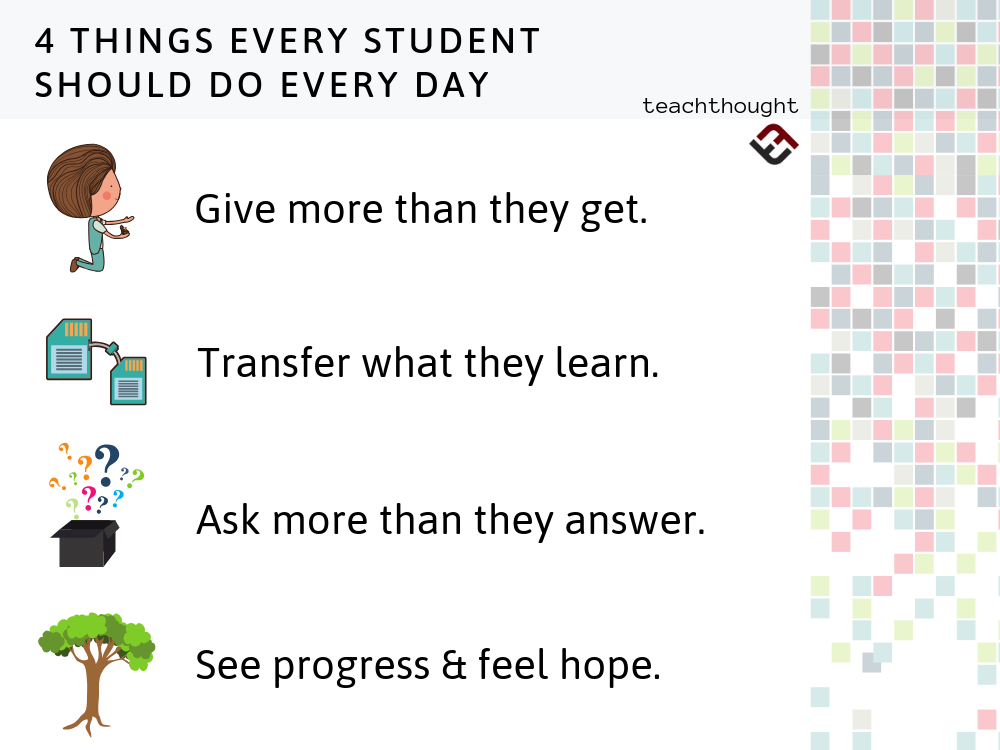
What 4 Things Should Students Do Every Day?
by Terry Heick
Just a quick post meant to be quantitatively modest (only four) and qualitatively useful/practical.
A list like this could get long fast. Off the top of my head, any teacher can come up with hundreds of ‘things’ it would be ‘good’ for students to ‘do’ every day. Critical thinking, intellectual empathy, creative expression, establish a sense of priority, distill important information, synthesize data from seemingly divergent perspectives to create something new, make decisions and reflect on the effects of those decisions in a meaningful way, and so on.
See also 6 Ways To Motivate Students Cognitively During Summer Break
We could go into reading and writing and research, or ‘soft skills’ like persevering and showing grit and making new friends, or talk about the difference between knowledge and skills and competencies and which they should ‘focus on.’
But, for once, I thought I’d keep it simple and create a quick-hitting and practical list useful for most teachers in most circumstances to help most students learn. Something you can look at, pick one, and make it happen tomorrow no matter what else you had planned.
So, to the list.
4 Things Every Student Should Do Every Day
1. Every day, students should give more than they ‘get.’
Every day, students should leave school feeling cognitive stretched and intellectually agitated. Changed. And for this to be sustainable over time (a critical component of the Inside-Out Learning Model), it has to come not from teachers, but students themselves.
This isn’t a new idea. There are other efforts that either paraphrase or support his effort. For years, teachers have been admonished to ‘never work harder than the students.’ Progressive education often refers to the shift for the role of the teacher from the ‘sage on stage’ to the ‘guide on the side.’ Suggesting that students ‘be the loudest voices in the room’ is parallel here, too.
Students should create, practice, collaborate, and design–more than they ‘sit and get.’ And so on. The big idea here is shifting the roles between teachers and students–and not just ‘holding students accountable’ any more than school districts seeks to ‘hold teachers accountable.’ Rather, this about tone and climate. Perspective.
And this can, in part, be accomplished by empowering students through self-direction, process ownership, cognitive engagement, and meaningful autonomy.
One Strategy: Use Project-Based Learning to center–and empower–students in your classroom.
One Resource: 5 Levels of Student Ownership
2. Every day, students should ask more questions than they answer.
Why should students ask more questions than they answer? Of course, quantity isn’t the point. But merely insisting on quality isn’t enough, either. More than anything else, a student’s tendency to consistently ask more–and better–questions is an indicator of not only ‘student engagement,’ but of curiosity, ownership, autonomy, and hope. (Imagine a student with no confidence or hope consistently asking great questions. It’s unlikely.)
One Strategy: How can you help students ask more questions than they answer? Start small. Maybe they can simply improve their questions–start with a question and make it better.
And in a perfect world, they’ll do this on their own, unprompted, using their own questions they asked to begin with. In the meantime, you may have to help them practice this skill in a cognitive (i.e., their ability to do so) and behavioral (i.e., their will and tendency to do so).
One Resource: An Updated Guide For Questioning In The Classroom
3. Transfer what they know from the classroom to their lives.
Because if they don’t, what’s the point of it all?
One Strategy: Learning journals that help students think, where students take a few minutes each day or night to reflect on the transferability of the knowledge they acquired and/or their tendency to do so. (And if they can’t do either, this is a great starting point to talk about curriculum, assessment, instruction, and so on in your school and district.)
One Resource: 14 Ways Students Can Transfer What They Know
4. Every day, students should feel a sense of progress and hope.
In other words, grow.
Progress and hope won’t always be equal or even clear. Some days, they both might be scarce. But any day that passes when a student feels no confidence, hope, improvement, or growth is a failure by everyone and thing who could’ve made it otherwise.
Of course, ‘hope’ is a vague concept that thankfully extends well beyond the classroom. The possibility of educating children with no hope (for today or the future) is a sobering one. And ideally, progress in the classroom yields a sense of hope at home if the relationship between curriculum and living is sufficiently direct.
One Strategy: How can you help students feel a sense of hope and progress? Part of this is will be owed to the nature and quality of the learning feedback they are given on a daily basis, which is difficult.
On a broader level, to really help students feel a sense of progress of hope requires a collaboration between curriculum and instruction that’s beyond the scope of this post. For now, simply try to visualize their progress over time. Pick one skill or ‘facet’ of their education and be creative. It could be attendance, literacy, test scores, participation in group work, meeting personal goals, etc. For now, it’s all about seeing progress.
You could also use gamification or even grade backward. Even ask the students for ideas. (See #1 above.) Keep in mind, this doesn’t have to be an ambitious effort. Instead, worry about the tone and effect of that effort over time in a sustainable way.
One Resource: 7 Categories For The Gamification Of Learning
Four-word Summary: Every day, students should Give, Question, Transfer, and Grow.
